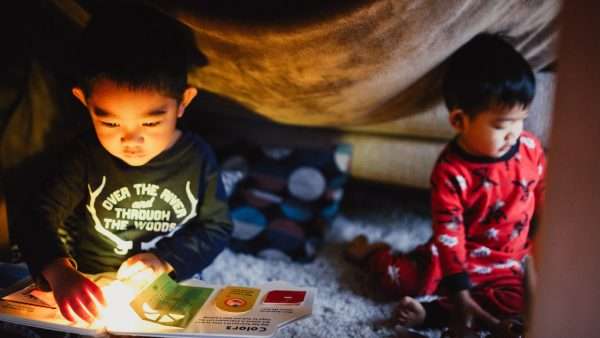by Patricia A. Malmstron, M.A.
Congratulations! Welcome to the grand adventure of twin care. If you’re anything like the rest of us parents who have given birth to multiples, it’s likely that you have little on your mind but survival-the babies and your own. You are doing everything you can to maintain a healthy pregnancy. And, you are making practical plans for organizing the household and getting the help you will need to function well in the sleepy fog that comes with the early days and weeks of baby care. As family and friends help you accomplish the practical things on your to-do list, you will begin to feel more in control. Your worries will fade a little. You will begin to believe that you really are going to have twins-or more-and to imagine what life will be like for your babies who are going to be born together.
“How will I bond with both or all of my babies at once?” you may wonder. This is a natural concern for we know that newborns need loving attention in order to thrive. The truth is you can indeed bond with two or more, but the process will be a little different from bonding with one single-born baby. Perhaps your experience won’t meet your expectations of falling equally in love with each of the babies on day one. More than likely your first bond will be with the group. In the early foggy days you will put one foot in front of the other to meet their needs. As one mother recalled, “Our life was a marathon of feeding, changing, burping, walking the floor, then starting all over again. Some days I couldn’t remember which baby had been fed and which one still needed his bath.” Gradually, through the haze of your daily routines, you will being to pick up the clues that each baby gives you about who they are and what they need. Harry may need to be walked for fifteen minutes to settle him down after every feeding. Roger, on the other hand, may fall asleep while nursing and need to have his feet tickled to keep him awake. As you respond to each of their individual needs, you and the babies will learn more about each other and your connections will deepen.
But supposing one or more of the babies has to stay in the hospital longer than the other? What then? How can you bond when your heart is stretched between the baby in the nursery at home and the one in the hospital? One dad explained, “We did our best to give each baby what he needed. We worried day and night about Andy in the hospital. We took turns visiting him and caring for Charlie at home. My mother came and helped with Charlie, too, so that Anne and I could visit Andy together sometimes. Knowing that Charlie was in good hands was a terrific relief.”
It’s true that newborns require consistent loving care, but they won’t mind if does not always come from you. Arrange for the best substitute care you can find. You will have plenty of time to get better acquainted when everyone comes home from the hospital. Remember that bonding is not a single event; it is a process. And you can take heart from the adage that “All good things take time.”
Keep in mind, too, the benefits the babies gain from their relationship. They have already bonded with each other in the womb. Research is beginning to produce evidence that newborn twins are a comfort to each other. The presence of one can even improve the other’s health. You may be able to tap this resource by arranging to bring the well baby for a visit with his or her co-twin in the hospital.
Whether or not your babies come home together or separately, the relationship between them will shape their lives right from the start. They are individuals who are born as members of a team. They will grow up with a strong relationship to the other members of their team. Their relationship bond brings with it life-enhancing possibilities which are seldom enjoyed by single-born children. Soon they will begin to light up with joy at the sight of each other. Their daily companionship during early childhood lays the foundation for lifelong comraderie. Even pairs who have a feisty relationship will come to each other’s defense when another child tries to take away a toy or a stranger is critical of one.
Their close connection also challenges common notions regarding the individuation process. Since they come into the world in a relationship with each other, they will experience and relate to you and the rest of their family both as individuals and as members of their team. They share many early experiences as a team, however, they each have their own perception of those experiences. You will soon discover that they are not the “two little bookends” one mother imagined before her girls were born.
The way parents respond to this reality affects the way multiples see themselves and it affects the way others relate to them, too. Now, before they arrive is a good time to think through the ways in which you will help yourself and others identify each child as an individual. People will have no trouble seeing the babies as a group!
An excellent place to start is with the choice of their names. As you go through the selection process keep in mind that names that are distinctly different from each other, like Susan and Jane, will help people learn who is who. Names that underscore the children’s status as multiples such as ones that begin with the same letter or sound very similar such as, Deanne and Leanne, make it difficult for others to remember which child is which.
Another arena in which you can help keep their identities straight is clothes. Dressed alike your babies will stop traffic for few can resist a peek at multiples. This attention-getting approach to their wardrobes can be fun now and then, but when practiced on a daily basis it submerges the children in their team and reduces the chances of their being treated like the individuals they are. I remember a pair of shy teenage girls who dressed alike every day. When their classmates asked why, they replied in unison, “We’re twins and twins are supposed to dress alike.” How sad for them that their devotion to twinship kept them isolated from their classmates.
All of the above may seem like abstractions until your babies are born and you experience the dynamics of their different personalities. They will quickly teach you about themselves by the ways in which they respond to you and their environment. One may be content to snuggle and sleep for long periods. Another may be wide-eyed and curious, following everything that goes on in the household. You may be surprised and amazed to find that although you are the one providing their nurture and care, they are the ones leading the way.
Patricia Malmstom, Director of Twin Services Consulting, is the co-author of The Art of Parenting Twins (Ballantine Books, 1999) and the mother of four adult children, including monozygotic “identical” twins.
Keys to developing individuality & supporting the twin relationship
• Give each baby what they need when they need it.
• Choose distinctive names.
• Dress babies differently from each other.
• Allow co-multiples to enjoy each other’s company.
• Teach respect for each other’s differences and similarities.






